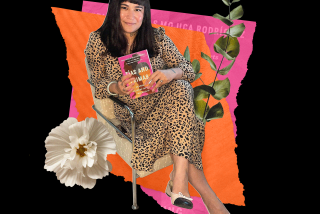A Scrappy Voice on L.A.’s Latino Arts Scene
- Share via
Boca has a chip on its shoulder.
You sense it in the alternative newspaper’s content.
You read it in the letters from fans who write to thank Boca for its stories or to say they hiss in the movie theaters when advertisements come on for a certain other big newspaper that has Los Angeles in its name.
You won’t find in Boca any of that Ricky Martin stuff the mainstream media call Latino culture for their mainstream audience.
Boca covers up-and-coming local artists who it says don’t register on the radar of the bigger publications but who have something important to say to the upwardly mobile and socially aware Latinos whom Boca views as its primary audience.
Boca praises the recently released film “La Otra Conquista” (The Other Conquest) for its portrayal of indigenous people’s experiences during the Spanish conquest and loathes DreamWorks’ “The Road to El Dorado” for what it perceives as the dehumanization of such indigenous people.
The chip on Boca’s shoulder has gotten bigger since its launch two years ago, when founder, publisher and editor Lorie Campos envisioned an alternative newspaper dedicated to Latino art and culture. But Latino life in L.A. extends beyond art into politics, Campos says, citing ballot propositions that would adversely affect Latinos, the hazardous contaminants discovered at the new Belmont High School site, frustrated Latino musicians who can’t get airplay on commercial radio stations and the upcoming mayoral election featuring two Latino candidates.
Four months ago, Boca--which Campos financed herself and which will increase from bimonthly to monthly in August--added a Politics label to its Art and Cultura coverage categories.
“I wasn’t a journalist before,” says Campos, 32, whose Lincoln Heights apartment’s second bedroom functions as Boca’s production office. “I was just a lover of culture and art from a distance. . . . Our focus has changed. We are trying to say the [things] that no one else will say.”
To be sure, Boca, which in Spanish means “mouth,” is a work in progress both in vision and professionalism--occasionally, a four-letter word in English or Spanish is accepted into the publication. Features in the April-May issue include a sort of Idiot’s Guide to Latino culture, a regular feature with bite that touches on everything from serious politics to inside jokes, and a piece on the bureaucracy artists face in getting their work shown outside their small networks. But Boca is gaining definition, Campos says, with each issue targeted at the acculturated Latino crowd whose members often don’t speak Spanish anymore but want to remain in touch with their community and reclaim their distinct heritage.
Other papers “don’t really capture the emerging 20-something, 30-something Chicanos here in Los Angeles, sort of with a social consciousness,” says Reuben De Leon, 30, development director at the Center for the Study of Political Graphics in Los Angeles. “It really unites the Chicano arts and literary community.”
Editor Embodies the Typical Reader
Campos, a former education lawyer before she started Boca, perhaps best exemplifies the kind of reader she targets.
She’s a third-generation Mexican American. Her father is college-educated. She doesn’t speak Spanish fluently, but her parents do because her grandmother can hardly speak English.
Campos grew up somewhat detached from her culture. She assimilated; she joined a sorority at UC Berkeley.
“It was a horrible, horrible experience. I just didn’t fit in,” she says. “I know it was because of the color of my skin.”
In its two years, Boca, with a circulation of 25,000, has been a presence at dozens of distribution points throughout Southern California, including colleges and bookstores. Campos says so far it can only afford to pay five of the nearly three dozen people involved in the paper, many of whom have volunteered as contributors after first reading it. She expects at some point, however, to earn more money from it than she did as a lawyer.
“People request [Boca],” says Ramon Pantoja, co-owner of Espresso Mi Cultura, a Hollywood coffee shop and gathering place for the kind of young Latino readers Boca is trying to reach. “I see it more as entertainment-related. They promote local Latino artists, but they don’t do the Hollywood thing.”
In November, Boca and Self-Help Graphics on the Eastside organized a sold-out concert at the John Anson Ford Amphitheatre in Hollywood featuring local acts such as Quinto Sol, Blues Experiment, Lysa Flores and the Mexican rock band Maldita Vecindad.
This year, Campos said she is negotiating with East Los Angeles Community College to bring the event to the Eastside. She hopes it will become an annual festival for the Day of the Dead--a Mexican holiday honoring the departed in early November.
Second Venture into Publishing
Boca is not Campos’ first venture into publishing. She considers herself a co-founder of the nationally distributed magazine Latina, which began as a college project with Christy Haubegger’s--now Latina’s publisher--while they were law students at Stanford in the early 1990s.
With financial support from Essence magazine, Latina became a bilingual version of English-language celebrity and beauty publications.
Campos decided to leave Northern California--and the project--about a year after graduating in 1992. She did so as she struggled with family matters, she says, including her parents’ desire for her to come back home and work as a lawyer.
Not many people know that Campos worked with Haubegger on the initial concept of Latina. In national stories about Haubegger in the wake of Latina’s success, the descriptions of Campos’ involvement with the magazine have ranged from no mention at all to a reference to a “friend of Haubegger” who left the project after three months.
Haubegger acknowledges that Latina was a collaboration of both women in its infant stages but considers others her co-founders: eight colleagues who raised money and developed a solid prototype in 1995--two years after she and Campos had parted ways, Haubegger says.
“It wasn’t easy for me,” Campos says of her decision to leave the magazine. “But my parents sacrificed a lot for me to go to Stanford. I just had to respect that.”
Besides, the two women also had different views about what their magazine should be, Campos said.
Initially, as the women looked for funding, Campos says, Lowrider magazine offered them financial assistance in bringing the publication to Los Angeles, a concept that Campos found appealing but Haubegger did not.
Campos also says she wanted a more serious women’s magazine that would not focus on stereotypical white concepts of beauty.
“I don’t think Latina adds anything to the dialogue of Latinos,” she says.
Latina, Haubegger says, practices good journalism with serious themes such as a recent story about Latinas forced into slavery in North Carolina.
Although they haven’t spoken in years, each still considers the other a friend.
Meanwhile, Boca has brought Campos back to the roots with which she finally feels comfortable as an adult--and has become a fierce guardian of the local Latino cultural scene.
“Why does everybody want to go national when there are so many beautiful things about Latinos in Los Angeles?” she asks.
Jose Cardenas can be reached at [email protected].
More to Read
The biggest entertainment stories
Get our big stories about Hollywood, film, television, music, arts, culture and more right in your inbox as soon as they publish.
You may occasionally receive promotional content from the Los Angeles Times.










